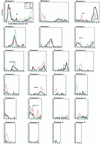Identification of novel susceptibility loci for inflammatory bowel disease on chromosomes 1p, 3q, and 4q: evidence for epistasis between 1p and IBD1
- PMID: 9636179
- PMCID: PMC22666
- DOI: 10.1073/pnas.95.13.7502
Identification of novel susceptibility loci for inflammatory bowel disease on chromosomes 1p, 3q, and 4q: evidence for epistasis between 1p and IBD1
Abstract
The idiopathic inflammatory bowel diseases, Crohn's disease (CD) and ulcerative colitis (UC), are chronic, frequently disabling diseases of the intestines. Segregation analyses, twin concordance, and ethnic differences in familial risks have established that CD and UC are complex, non-Mendelian, related genetic disorders. We performed a genome-wide screen using 377 autosomal markers, on 297 CD, UC, or mixed relative pairs from 174 families, 37% Ashkenazim. We observed evidence for linkage at 3q for all families (multipoint logarithm of the odds score (MLod) = 2.29, P = 5.7 x 10(-4)), with greatest significance for non-Ashkenazim Caucasians (MLod = 3.39, P = 3.92 x 10(-5)), and at chromosome 1p (MLod = 2.65, P = 2.4 x 10(-4)) for all families. In a limited subset of mixed families (containing one member with CD and another with UC), evidence for linkage was observed on chromosome 4q (MLod = 2.76, P = 1.9 x 10(-4)), especially among Ashkenazim. There was confirmatory evidence for a CD locus, overlapping IBD1, in the pericentromeric region of chromosome 16 (MLod = 1.69, P = 2.6 x 10(-3)), particularly among Ashkenazim (MLod = 1.51, P = 7.8 x 10(-3)); however, positive MLod scores were observed over a very broad region of chromosome 16. Furthermore, evidence for epistasis between IBD1 and chromosome 1p was observed. Thirteen additional loci demonstrated nominal (MLod > 1.0, P < 0.016) evidence for linkage. This screen provides strong evidence that there are several major susceptibility loci contributing to the genetic risk for CD and UC.
Figures


References
Publication types
MeSH terms
Substances
Grants and funding
LinkOut - more resources
Full Text Sources
Other Literature Sources
Medical
Molecular Biology Databases

